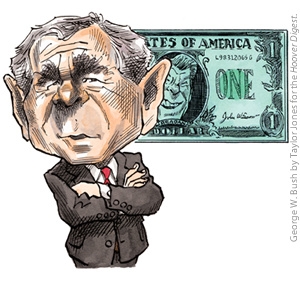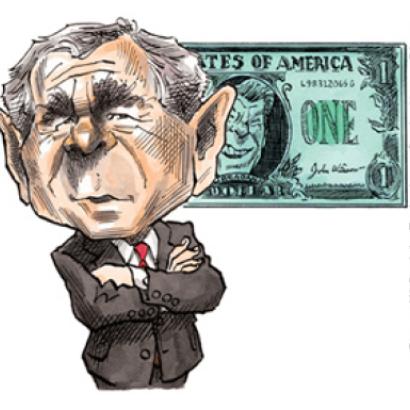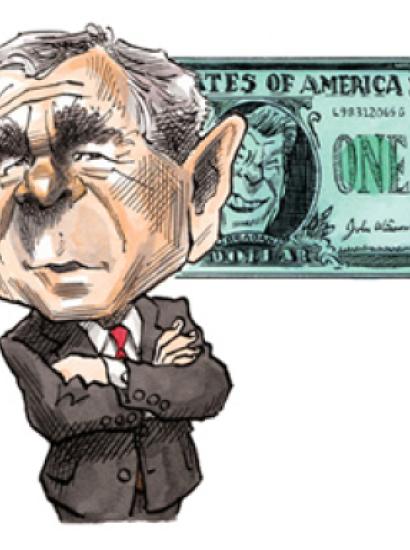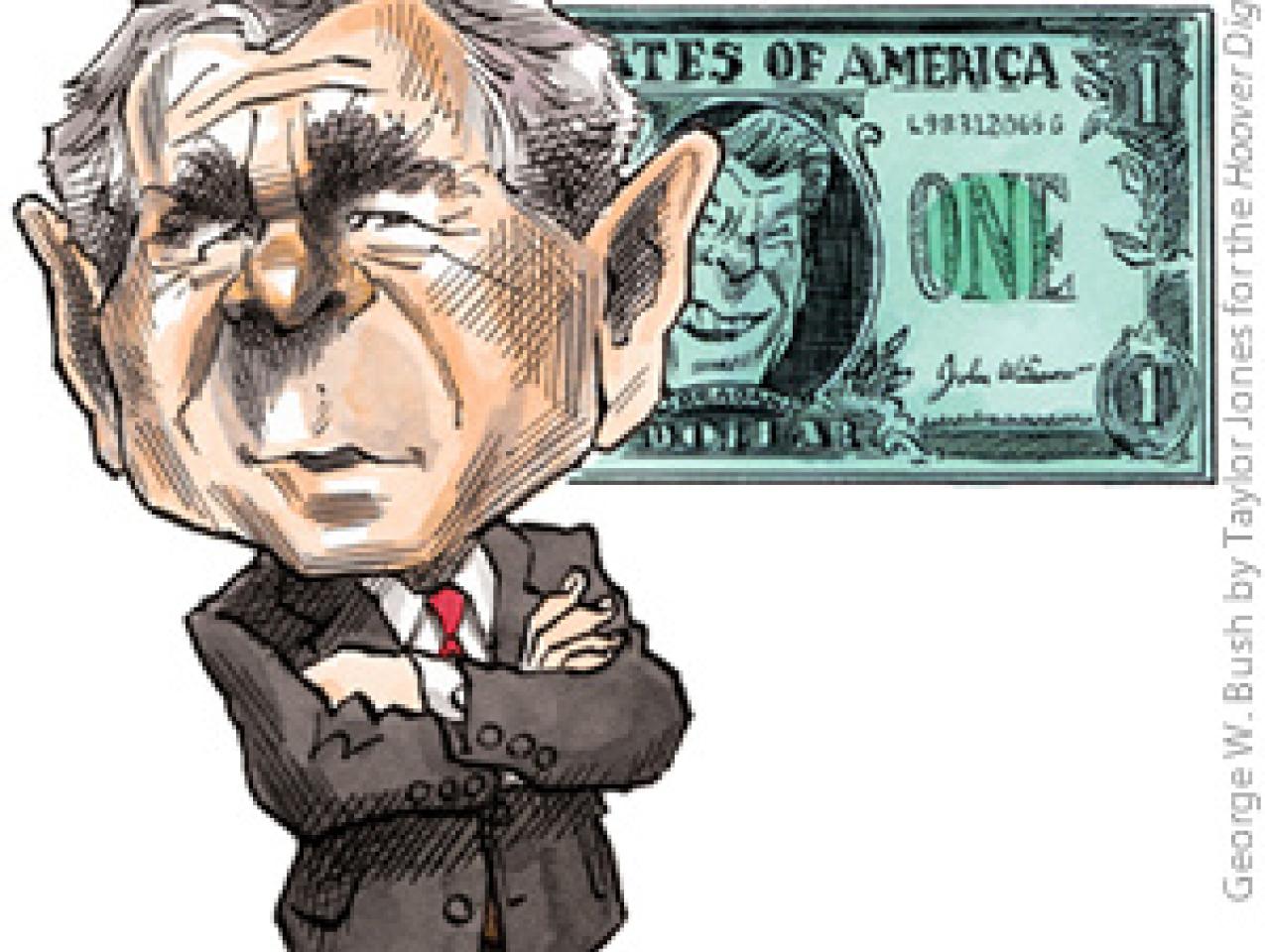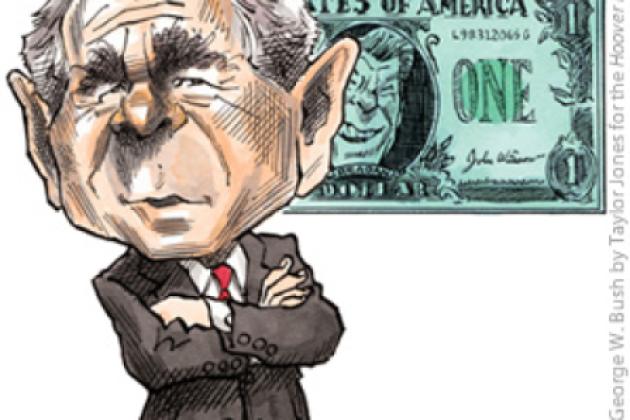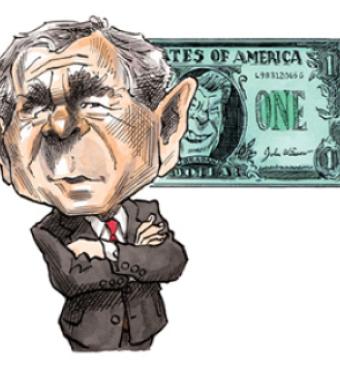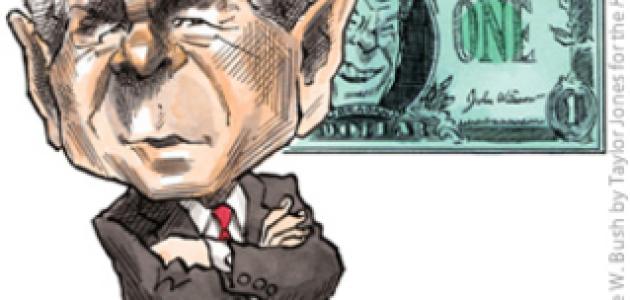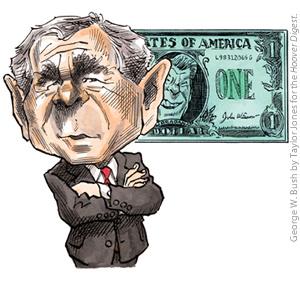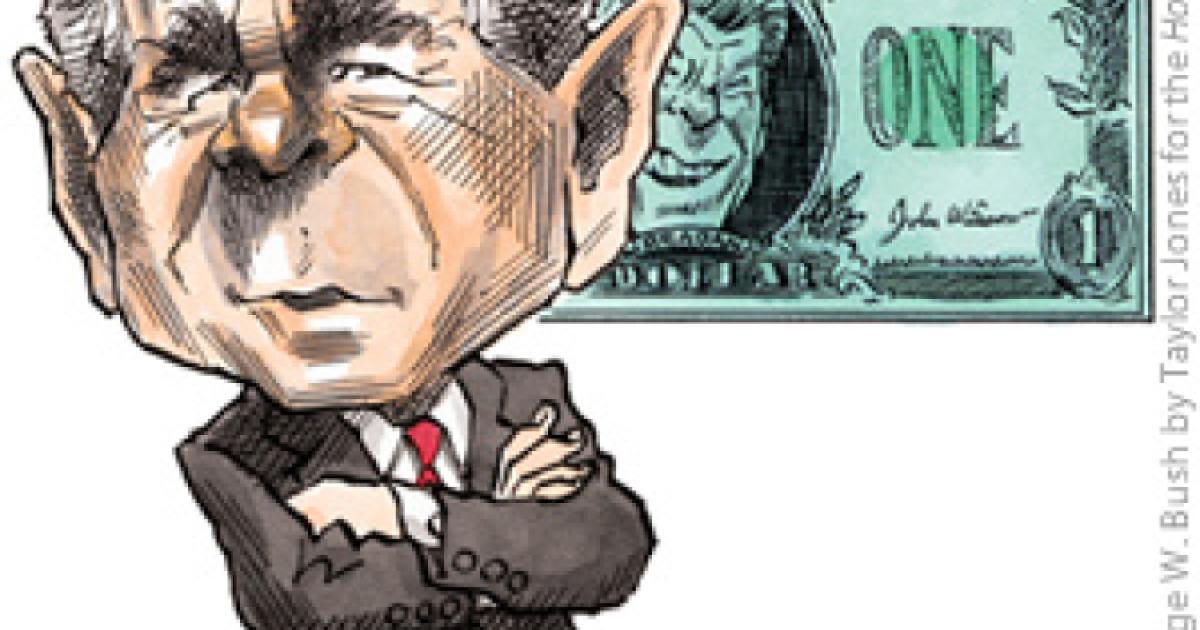- Budget & Spending
- Economics
- The Presidency
- Politics, Institutions, and Public Opinion
President Bush deserves generally very high marks on economic policy in his first term, although there were some stumbles (e.g., too much non-defense spending growth, steel tariffs). His approach to economics and economic policy—a combination of philosophical principles and practical business experience—will continue to serve him well in his second term. Even before the formal start of his first campaign for president, George W. Bush thought of the presidency not just as an office to hold, an in-box, but as an opportunity to lead and to accomplish important goals for our country. At the top of his list of important issues were (1) cutting taxes (to prevent unnecessary wasteful spending that had accelerated abruptly in the second Clinton term, to strengthen the supply side of the economy for long-run growth, and to insure against the economic downturn his advisers, myself included, unfortunately prophetically, thought likely after Y2K); (2) rebuilding and transforming the military to fight and win the wars of the twenty-first century following the steep decline under Clinton; (3) reforming the entitlement programs, especially Social Security and Medicare, to deal with their long-run insolvency and to modernize them; and (4) reforming the tax system. To be sure, there were other important goals in education, energy, trade, regulation, and litigation, but the above were at the top of his list.
He has made considerable progress in each of these areas, but much remains to be done in a second term. And the economic environment at the start of the second term is quite different from that at the start of the first term. First, the economy is in an expansion and is likely to approach full employment over the next year or two, not sliding into recession following a stock market bubble and crash. Second, the stock market crash, recession, and homeland security and military spending needs have changed the fiscal environment from one of large (partly temporary) budget surpluses to sizable budget deficits (again, partly temporary). Third, several of his signature initiatives have important features that are due to expire (e.g., the reductions in marginal tax rates) or have not yet been implemented (how to pay for the prescription drug benefit added to Medicare as of 2006).
In light of this, what should the second-term agenda be? Start with what is good economic policy. Economic policy should be aimed primarily at maximizing non-inflationary growth. That requires (1) the lowest possible tax rates; (2) continuously rigorous spending control; (3) reform of Social Security and Medicare; (4) regulatory and litigation reform; (5) trade liberalization; and (6) sound monetary policy.
Thus, make the lower marginal tax rates—so important to strengthening incentives in the economy—permanent. Tax reform should at the least lower them further and broaden the tax base by eliminating or combining deductions, exemptions, credits, and definitions. It is not widely appreciated that, under current law, the federal tax share of GDP is scheduled to rise enormously, to almost 25 percent, due to real bracket creep, the alternative minimum tax, and other factors. Thus, tax cuts will be necessary to prevent a huge future tax drag on the flexibility and dynamism of the economy. It is also not appreciated how much reform was included in the president’s first-term tax cuts: lower marginal rates, reduced marriage penalty, lowered tax rates on dividends—all were steps toward economists’ notions of an ideal tax system, especially reducing the double and triple taxation of saving.
Continuously rigorous spending control is vital. Everything else follows from serious tests of whether it is necessary for government to be spending and, if so, whether that spending should be federal, state, or local and whether the funded programs are target-effective and cost-conscious. We have a large problem because so much government spending is not effective (OMB estimates that only 30 percent of programs have demonstrated even modest effectiveness). The spending problem may be more visible because of large budget deficits, but we would have a serious spending problem even if the budget were balanced. So redouble the good start finally made this year in slowing non-defense discretionary spending growth (after seven years of rapid growth). Expand performance budgeting. Expose and restrict or eliminate ineffective programs.
Modernize Social Security with a personal account component, but combine this with other reforms, such as future changes in retirement age, price- instead of wage-indexing initial benefits, at least above some threshold, and so forth. The Bureau of Labor Statistics (BLS) should make some additional improvements in the consumer price index. Implementing the so-called Chained-CPI it has been computing for several years now—to account for consumers adjusting their buying habits to relative price changes, as called for by the commission I chaired in 1996—will more accurately measure inflation and, incidentally, decrease the national debt by more than a trillion dollars in coming decades. Above all, reduce the unfunded potential future liabilities (they are not legal obligations like Treasury bonds) first. Do not make them explicit first and then reform the structure. That would lock in large unnecessary real growth in spending and taxes.
The administration must do away with the misleading language that labels large real benefit increases as benefit cuts if it is to successfully reform Social Security. Future benefits based on the current formula cannot be sustained without large tax increases. Further, annual benefits, which are due to rise substantially in real terms, are due to be paid for more years as life expectancies rise. In short, large real benefit increases will be trimmed back but will still be higher than current levels. Honest discussion would label only decreases from current levels as reductions, not the Washington-speak obsession that labels slowing projected growth as “cuts.”
Continue the reform of regulation by redoubling the effort for serious scientific cost-benefit analyses and rigorous risk-benefit analyses. The first-term attempts at specific litigation reform (asbestos, medical malpractice, etc.) should be tried again, but also consider a modified loser-pays-the-costs system that would target the frivolous litigation explosion at its source.
Press ahead with your bilateral and regional free trade agreements, but redouble efforts on the Doha round of multilateral trade liberalization, which is important to U.S. economic interests but even more important to the developing world. It should be a centerpiece of your foreign as well as economic policy.
None of this will be possible with poor monetary policy (e.g., as in the 1970s). Sound monetary policy is essential to durable economic expansions and strong long-term growth. Although Paul Volcker and Alan Greenspan deserve great credit for the far better monetary policy of the last quarter century, do not take high-quality central banking for granted. Make sure you appoint talented, knowledgeable professionals with backbone to the Federal Reserve’s Board of Governors, especially when you appoint a successor to Chairman Greenspan.
Most of the attention on economic policy will focus on the budget deficit. Rigorous spending control and the lowest possible tax rates will keep the deficit and debt/GDP ratio well under control, but don’t be misled by large-headline, nominal deficit numbers. Adjusting for cyclical conditions, the inflation erosion of the real value of the previously issued debt, and a separate capital account for federally financed net investment and the military buildup, recent deficits were quite reasonable. As the economy returns to full employment and most of the temporary military spending buildup concludes, deficits not exceeding 2 percent of GDP will stabilize or reduce the debt-GDP ratio and would be balanced by the inflation erosion and net investment (i.e., would not be debt financing current public consumption).
In the hurly-burly of political debate, keep reminding all of us—Congress, policymakers, most of all, the public—that, just like a football, basketball, or baseball team, the agenda you are fighting for adds up to more than the sum of its parts. A more modest role of government, lower and simpler taxes, slow growth of spending, modernized solvent entitlements, trade liberalization, regulatory and litigation reform, and support for sound monetary policy is the recipe most likely to lead to rising living standards, low unemployment, long economic expansions, less-frequent recessions, better-paying jobs, and upward mobility for those who have not yet made it up the economic ladder. And the alternative of more spending, higher taxes, more regulation, and the like is the poisonous brew that has led so many other developed economies, especially in Europe, to economic stagnation, double-digit unemployment, and socioeconomic ossification.
This essay appeared in the Wall Street Journal on January 24, 2005.
Available from the Hoover Press is Frontiers of Tax Reform, edited by Michael J. Boskin. To order, call 800.935.2882.
